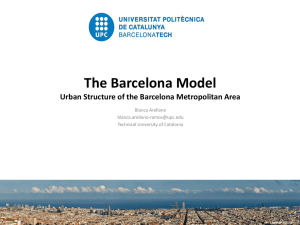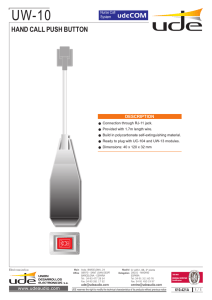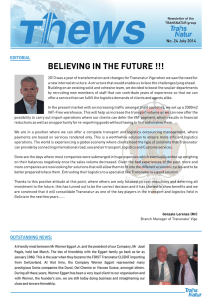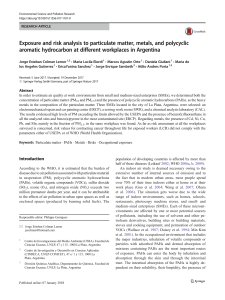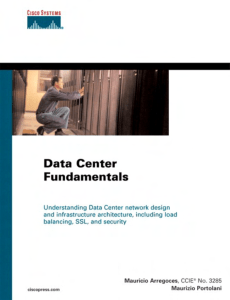Effects of the 80km/h and variable speed limits on air pollution in the
Anuncio
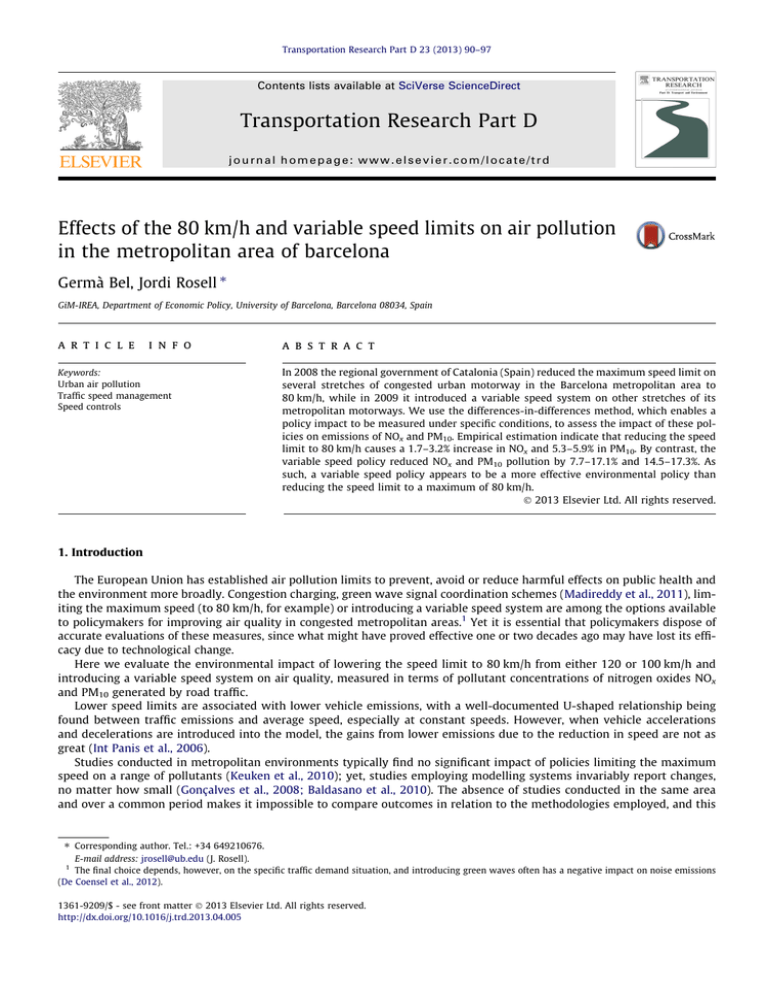
Transportation Research Part D 23 (2013) 90–97 Contents lists available at SciVerse ScienceDirect Transportation Research Part D journal homepage: www.elsevier.com/locate/trd Effects of the 80 km/h and variable speed limits on air pollution in the metropolitan area of barcelona Germà Bel, Jordi Rosell ⇑ GiM-IREA, Department of Economic Policy, University of Barcelona, Barcelona 08034, Spain a r t i c l e i n f o Keywords: Urban air pollution Traffic speed management Speed controls a b s t r a c t In 2008 the regional government of Catalonia (Spain) reduced the maximum speed limit on several stretches of congested urban motorway in the Barcelona metropolitan area to 80 km/h, while in 2009 it introduced a variable speed system on other stretches of its metropolitan motorways. We use the differences-in-differences method, which enables a policy impact to be measured under specific conditions, to assess the impact of these policies on emissions of NOx and PM10. Empirical estimation indicate that reducing the speed limit to 80 km/h causes a 1.7–3.2% increase in NOx and 5.3–5.9% in PM10. By contrast, the variable speed policy reduced NOx and PM10 pollution by 7.7–17.1% and 14.5–17.3%. As such, a variable speed policy appears to be a more effective environmental policy than reducing the speed limit to a maximum of 80 km/h. Ó 2013 Elsevier Ltd. All rights reserved. 1. Introduction The European Union has established air pollution limits to prevent, avoid or reduce harmful effects on public health and the environment more broadly. Congestion charging, green wave signal coordination schemes (Madireddy et al., 2011), limiting the maximum speed (to 80 km/h, for example) or introducing a variable speed system are among the options available to policymakers for improving air quality in congested metropolitan areas.1 Yet it is essential that policymakers dispose of accurate evaluations of these measures, since what might have proved effective one or two decades ago may have lost its efficacy due to technological change. Here we evaluate the environmental impact of lowering the speed limit to 80 km/h from either 120 or 100 km/h and introducing a variable speed system on air quality, measured in terms of pollutant concentrations of nitrogen oxides NOx and PM10 generated by road traffic. Lower speed limits are associated with lower vehicle emissions, with a well-documented U-shaped relationship being found between traffic emissions and average speed, especially at constant speeds. However, when vehicle accelerations and decelerations are introduced into the model, the gains from lower emissions due to the reduction in speed are not as great (Int Panis et al., 2006). Studies conducted in metropolitan environments typically find no significant impact of policies limiting the maximum speed on a range of pollutants (Keuken et al., 2010); yet, studies employing modelling systems invariably report changes, no matter how small (Gonçalves et al., 2008; Baldasano et al., 2010). The absence of studies conducted in the same area and over a common period makes it impossible to compare outcomes in relation to the methodologies employed, and this ⇑ Corresponding author. Tel.: +34 649210676. E-mail address: [email protected] (J. Rosell). The final choice depends, however, on the specific traffic demand situation, and introducing green waves often has a negative impact on noise emissions (De Coensel et al., 2012). 1 1361-9209/$ - see front matter Ó 2013 Elsevier Ltd. All rights reserved. http://dx.doi.org/10.1016/j.trd.2013.04.005 G. Bel, J. Rosell / Transportation Research Part D 23 (2013) 90–97 91 thwarts any efforts to determine which method might be most suitable. We evaluate the impact of a variable speed limit using real motorway data. The positive impact of variable speeds on traffic safety seems to be the result of speed reductions and speed homogenization. The implementation of a system of variable speeds generally improves the uniformity of traffic flows and congestion, has a positive effect on the treatment of shock waves, and reduces the average speed and speed variability. Additionally, the homogenization of speeds reduces the number of vehicle accelerations and decelerations. 2. Methodology In July 2007 the regional government of Catalonia (Spain) passed the Action Plan for Improving Air Quality in the Barcelona Metropolitan Region, which included a reduction in the maximum speed limit to 80 km/h on motorways in the area. This new limit affected 19 municipalities with a population 1.35 million, but left the city of Barcelona unaffected given that the limit prior to this measure did not exceed 80 km/h on any of its motorways. Before the new limit was imposed, 63.2% of the affected roads had a speed limit of 100 km/h and 20.4% of them operated a limit of 120 km/h. According to the government, the measure aimed to bring Catalonia into line with European legislation on air quality and noise reduction, and they expected to see a reduction in pollution and a consequent increase in life expectancy. In February 2011, however, the newlyelected regional government lifted the 80 km/h maximum speed limit, in fulfillment of its electoral promise. Most roads returned to similar speed limits to those in force in 2007, although a central government regulation issued in March 2011 reduced the maximum speed on all Spanish motorways from 120 to 110 km/h. A second measure included in the Action Plan was the introduction in January 2009 of a variable speed limit system on sections of the C31 and C32 city access routes (southern motorways). On these two motorways, the speed limit was henceforth to vary in accordance with traffic density, specific incidents impacting road safety (accidents, construction or maintenance work, etc.), air pollution levels or poor weather conditions (rain, fog, winds, etc.). The system provided for incremental reductions of 10 km/h from a maximum of 80 to a minimum of 40 km/h, the speed limit being communicated to drivers via variable message boards located approximately every kilometer and enforced by means of radar detection and fines. In addition to seeking to improve environmental conditions, this variable system also sought to reduce stop-and-go traffic. In 2011, the newly-elected regional government did not impose the previous system, but rather after canceling the 80 km/h speed limit, announced the progressive expansion of the variable speed system to other highways in the Barcelona Metropolitan Area. We use data supplied by various entities of the regional government of Catalonia. Pollutant concentrations are provided by 15 air quality surface stations in the Barcelona metropolitan area. The time period studied extends from 2006 to 2010, and includes 1826 daily observations. Earlier periods are not included due to the small number of air pollutant and traffic monitoring stations in operation. 2010 is the last year in which the 80 km/h maximum limit was in force.2 The network of pollutant monitoring stations limits our study, albeit that the Barcelona metropolitan area has one of the densest networks of such stations in Europe (Baldasano et al., 2010). After selecting a station, we then proceeded to choose the traffic station in the same town. The weather station could in fact be located outside the municipality, provided that the difference in altitude between this and the other two stations did not exceed 200 m or they were not more than 10 km apart. Two dependent variables are used: nitrogen oxide (nitric oxide and nitrogen dioxide) and particulate matter 10 lm or less in aerodynamic diameter. NOx and PM10 are designated as priorities and we focus our attention on them. NOx measurements are taken every hour and the daily average was calculated from the day’s observations provided by the station. PM10 concentrations are sampled manually on a daily basis, which means few measurements are available for weekends and holidays. The data are provided by the regional government’s Air Monitoring and Control Service. The explanatory variables selected (see Table 1 for these and their main descriptive statistics) aim to capture the variability in pollutant sources and the transport, sedimentation and/or reaction of the pollutants. Our traffic data include the number of vehicles passing a specific kilometric point located as close as possible to the station measuring pollution on the motorway. Measurements are taken every hour in both directions, with 48 measurements being obtained daily. However, if all 48 measurements were not recorded, the observation was excluded. Data are provided by the regional government’s Traffic Service. As discussed earlier, the evolution in traffic volumes enables us to capture the effect of other sources of pollutants. Fig. 1 shows the evolution in the rates of variation susceptible to pollution sources: the rate of change in Catalonian GDP, the variation in the number of vehicles on the roads inside and outside the speed limit area, the variation in electricity demand in Spain, the variation in the number of passengers carried at Barcelona airport, and the variation in the number of passengers using public transport. The graph shows how rates fell slightly from 2007 onwards, reaching a minimum level in 2009 of between 2% and 10%. As expected, the slowdown in the economy reduced road traffic, electricity demand, and the number of passengers carried at Barcelona airport. The implementation of the 80 km/h speed limit and the variable speed system on high capacity roads might mean that many drivers choose to use urban secondary roads (spillage effects); however, the two-way traffic volume on these roads with a speed limit of 50 km/h remains largely unchanged. The municipalities of the Barcelona metropolitan area have likewise implemented measures to divert vehicles away from their urban areas, by introducing 30 km/h speed limits or by 2 A new speed regime introduced in March 2011 does not resemble any of the earlier schemes. More than 75% of motorways in the control zone were affected by the new Spanish measure, making it impossible to compare scenarios beyond January 2011. 92 G. Bel, J. Rosell / Transportation Research Part D 23 (2013) 90–97 Table 1 Explanatory variables and descriptive statistics. Variables Description Mean Standard deviation Average observations per pollutant station NOx PM10 Nitrogen oxide daily average concentration (lg/m3) Particulate matter daily average concentration with less than 10 lm (lg/m3) One period lag variables (1 day) 84.46 40.7 59.95 19.11 1743 626 Binary variable: 1 if 80 km/h speed limit is implemented. 0 otherwise Binary variable: 1 if variable speed is implemented. 0 otherwise Daily vehicles on both ways (taken in logarithms) Daily average temperature (°C) Daily average relative humidity (%) Daily rainfall (mm) Daily average wind speed (m/s) Daily average atmospheric pressure (hPa) 0.47 0.50 2191 0.07 0.25 2191 0.43 6.32 11.65 5.86 2.74 25.42 1500 1472 1472 1473 1020 1035 NOx(1) and PM10(1) 80 km/h speed limit zone Variable speed Traffic Temperature Relative humidity Precipitation Wind speed Atmospheric pressure 11.352 16.51 66.85 1.56 3.298 1014.8 promoting public transport. The impact of these measures on traffic, however, is almost imperceptible and Fig. 1 does not show a marked increase in the number of public transport passengers. Moreover, not only are there relatively few secondary roads leading into Barcelona, but there has also been no increase in traffic after 2008.3 The atmosphere is characterized by multiple interactions. The meteorological variables are to capture this variability. Contaminants can be transported, so we include the average daily wind speed. Pollutants are not only transported, they also undergo reaction processes. The rates of these reactions are influenced by temperature, so the average daily temperature is included. This is closely related to solar irradiance, which affects the reaction balance. Water can bring a reactive change in the equilibrium or increase sedimentation, so we include relative humidity and daily rainfall. Atmospheric pressure means movements of air masses ascending or descending and wind formation. For each station, atmospheric pressure is transformed into atmospheric pressure at sea level. All meteorological variables except rainfall are daily averages calculated by the regional government meteorological station. The variable of interest is the dummy for the 80 km/h speed limit area that takes the value one for stations closest to roads on which the 80 km/h limit came into force on 1 January 2008 and for stations in Barcelona city throughout the entire period. The variable takes the value zero for stations in the period prior to the introduction of the measure and for those stations lying outside the 80 km/h limit area over the entire period. For our estimations, we consider 1 January 2008 as the date on which the policy came into force in the affected areas.4 The variable for the variable speed system takes a value of unity for stations closest to roads on which the variable speed limit came into force on 15 January 2009 and zero otherwise. Only three of the 15 stations fell under the influence of the variable speed policy and these also take the value one for the 80 km/ h variable. The regression of each pollutant is accompanied by its temporal lag. We estimate the atmospheric concentration of pollutants in Barcelona metropolitan area municipalities for 2006–2010 to assess the impact of road speed limits. In the absence of a randomized trial, the method adopted is a slight extension of the differences-in-differences estimation procedure specified as a two-way fixed effects model; Y it ¼ bX it þ cZ it þ hi þ dt þ eit ð1Þ where Yit is air pollutant concentration, Xit contains the vector of time-varying control covariates, and Zit are the policy dummy variables to be evaluated. As usual, hi and dt are municipal-specific and time-specific fixed effects and eit is a mean-zero random error. Municipal fixed effects control for time-invariant municipal-specific omitted variables, and time fixed effects control for municipal trends. The key element in this differences-in-differences model is c, which measures the difference between the average change in air pollutant concentrations for the treatment group (i.e., zones with an 80 km/h speed limit or zones with a variable speed limit) and the average change in concentrations for the control group (i.e., zones with a speed limit exceeding 80 km/h or in which a variable speed is not implemented). Specifically, c ¼ ½EðY B =G ¼ 1Þ EðY A =G ¼ 1Þ ½EðY B =G ¼ 0Þ EðY A =G ¼ 0Þ ð2Þ 3 Data on transit in the metropolitan area of Barcelona can be obtained from the Barcelona City Council. http://w3.bcn.es/fitxers/mobilitat/ dadesbasiques2010complert.338.pdf. 4 The measure was first introduced in December 2007, but drivers who exceeded the 80 km/h limit were not penalized until 1 January 2008 when radar controls were installed. G. Bel, J. Rosell / Transportation Research Part D 23 (2013) 90–97 93 Fig. 1. Rates change temporal evaluation of pollution sources and GDP. where YB and YA denote the air pollutant concentrations before and after the change in the law and G = 1 and G = 0 denote treatment and control group observations respectively. The differences-in-differences method was deemed appropriate for the following reasons. First, we do not need to know all the variables that affect the pollutant concentrations since we can assume that they remain constant before and after the policy came into force. Second, the method solves the problem, when modelling air quality in the study area, created by missing data for both participants and non-participants in the periods before and after the measure came into force. Third, it allows us to discern how much of the change is attributable to policy impact and how much would have occurred regardless of the implementation of a speed limit policy. Finally, the method allows us to avoid selection bias due to unobservable factors affecting the model. A basic assumption of differences-in-differences models is that the temporal effect in the two areas is the same in the absence of intervention. We test for the equality between average changes in the two groups in the pre-treatment period to assess the plausibility of the fundamental identifying assumption. This endogeneity test is important, although it is often overlooked in the differences-in-differences methods applied in the literature. Our null hypothesis H0 is equality in the trend between the two groups and we are unable to reject the null hypothesis for NOx and PM10 at a 95% confidence level. These results imply non-biased estimates of NOx and PM10 air quality levels. Most problems related to endogeneity can usually be avoided by using the differences-in-differences method (Bertrand et al., 2004). For instance, between 2006 and 2007, annual average concentrations of many pollutants fell, especially in what would be designated the 80 km/h speed limit area from 2008 onwards (Table 2). This suggests that policy implementation does not respond to air quality deterioration in the years immediately preceding the enforcement of speed reduction measures. As such, endogeneity problems that might bias policy effects can be avoided. It should likewise be noted that none of the political parties that was to form the coalition government had proposed the introduction of an 80 km/h speed limit in their election programs, a step that would have conditioned the adoption of the measure. Unobservable factors should not be underestimated in evaluations such as those conducted here. These factors can be classified into two types: those that are fixed throughout the program and those that vary over time. One of our assumptions is that the unobservable factors remain constant over time. The large number of time periods employed here ensures that the problems to which this type of assumption might give rise can be minimized. When using differences-in-differences, regressions must be undertaken with fixed effects: the correlation between the error component of station hi and the explanatory variables is different from zero. We conduct the Hausman test and are able to reject the null hypothesis at the 99% level, our fixed effects assumption being correct. Panel data errors from different stations may be correlated (contemporary correlation), and within each unit there may be temporal correlation (autocorrelation or serial correlation). Pollution levels do not change from day to day, so something that happens today has an impact on what happens tomorrow. Similarly, if the error variance is not constant, we may find heteroscedasticity. With cross-sectional or time series measurements this may often be the case; besides, the error term might vary from one station to another. To detect autocorrelation we use the Wooldridge test and find an autocorrelation scheme. To detect heteroscedasticity we use the modified Wald test and reject the constant variance null hypothesis. The contemporary correlation means that the non-observable features of some municipalities are related to the non-observable characteristics of other municipalities. 94 G. Bel, J. Rosell / Transportation Research Part D 23 (2013) 90–97 Table 2 Pollutants average concentration per years and areas. 80 km/h speed limit zone NOx (lg/m3) PM10 (lg/m3) Year 80 zone Outside 80 zone 80 zone Outside 80 zone 2006 2007 2008 2009 2010 89.6 75.0 68.6 63.7 59.4 75.1 74.3 71.2 67.3 69.8 49.4 45.9 41.9 41.1 30.3 52.1 44.7 39.6 38.5 29.6 Variable speed zone (inside 80 km/h speed limit zone) Year NOx (lg/m3) PM10 (lg/m3) 2006 2007 2008 2009 2010 57.5 62.7 61.2 60.9 57.5 39.7 41.0 35.9 34.5 31.0 One problem that we encounter is the spatial correlation between pollution stations, even though our pollution stations were subject to random selection. To test for spatial dependence, we use the Pesaran test. While this test introduces distortions when N is large and T is finite, our case presents just the opposite dimensions. Applying the test for fixed effects, we obtain spatial dependence for the two dependent variables. We use the Breusch–Pagan test of the null hypothesis of crosssectional independence, which is rejected. Taking this into account, we have autocorrelation, heteroscedasticity and contemporary correlation; problems that can be solved with feasible generalized least squares (FGLSs) or panel corrected standard errors (PCSEs), although it has been demonstrated that PCSE provide more accurate standard errors (Beck, 2001). We estimate by ordinary least squares (OLSs), allowing for heteroscedasticity, contemporary correlation and following an AR1 autocorrelation scheme. As for the recommendation that the number of time periods should be greater than that of sampling stations, recall that we have 2191 periods compared to 15 stations. Spatial dependence can arise if the cross-sectional units (pollutants stations) are correlated. Driscoll and Kraay (1998) demonstrate that the standard nonparametric time series covariance matrix estimator can be modified so that it is robust to cross-sectional and time dependence. This estimator also produces heteroscedasticity-consistent standard errors. So, we also estimated the policy impact with the Driscoll–Kraay scheme. 3. Results The results of the pollutant estimations are reported in Tables 3–5. The Wald test shows the variables to be jointly significant at 1%, while the R2 model fit value ranges between 0.50 and 0.38 depending on the pollutant.5 Tables 3 and 4 show the results from four models; both sets adhere to the panel corrected standard errors methodology. The introduction of the 80 km/h speed limit resulted in an increase in NOx concentrations of between 1.9 and 1.3 lg/m3. If we take the average NOx concentrations in the speed limit area for 2007, the enforcement of the new limit meant an increase in NOx concentrations of between 1.7% and 2.5%. In the case of PM10 specification, we found an increase of between 5.4% and 5.7%. By contrast, the variable speed system variable is highly significant and negative for all pollutants. We found an NOx reduction of between 16% and 17.1% and a PM10 reduction of between 14.7% and 17.3%. Our reference is the pollution levels in 2008, the year before the measure was introduced. Traffic volume is significant in accounting for the concentration of all pollutants with the exception of some PM10 specifications. The sign is always positive, indicating that a greater traffic volume increases pollutant emission levels, which is consistent with available evidence. The coefficient’s significance and the expected sign highlight the importance of traffic volume as a proxy for emissions from sources other than from traffic, and show how these correlate with the economic cycle. The pollutant concentration in the previous period is significant in all regressions. Thus, 37% of NOx levels are explained by the previous day’s concentration, while this rises to 57–58% in the case of PM10. On days with rain we found a significant reduction in PM10 and NOx concentrations, whereas the concentration of all pollutants increased with higher atmospheric pressure, indicative of a more stable atmosphere. An increase in average wind speed resulted in lower pollutant concentrations for all pollutants, the wind acting as a dispersant in the Barcelona metropolitan area. The average temperature and average humidity variables also have an important explanatory capacity in the model, being significant for most regressions. However, these specific variables impacted the pollutant equilibrium equations, and any interpretation of these equations falls outside the scope of our analysis. 5 In line with Currie and Walker (2011), we also estimate both models for SO2 emissions and find the policy variables are not significant, and the explained variability of the model is below 8%. 95 G. Bel, J. Rosell / Transportation Research Part D 23 (2013) 90–97 Table 3 Estimation with panel corrected standard errors (NOx). Dependent variable: NOx Specifications 80 km/h speed limit Variable speed Traffic NOx temporal lag Temperature Humidity Rainfall Wind speed Atmospheric pressure Year 2007 Year 2008 Year 2009 Year 2010 R2 No. observations Joint significance 1.887⁄⁄ 10.462⁄⁄⁄ 17.240⁄⁄⁄ 0.375⁄⁄⁄ 1.065⁄⁄⁄ 0.248⁄⁄⁄ 0.100⁄ 2.153⁄⁄⁄ 0.349⁄⁄⁄ 11.165⁄⁄⁄ 8.264⁄⁄ 5.473 1.797 0.38 9159 4825.4*** 1.308⁄ – 17.108⁄⁄⁄ 0.375⁄⁄⁄ 1.060⁄⁄⁄ 0.246⁄⁄⁄ 0.099⁄ 2.142⁄⁄⁄ 0.348⁄⁄⁄ 10.870⁄⁄⁄ 7.850⁄⁄ 6.101⁄ 2.117 0.38 9159 4807.7*** – 9.811⁄⁄⁄ 17.431⁄⁄⁄ 0.375⁄⁄⁄ 1.053⁄⁄⁄ 0.239⁄⁄⁄ 0.096⁄⁄⁄ 2.181⁄⁄⁄ 0.338⁄⁄⁄ 10.307⁄⁄⁄ 6.940⁄⁄ 4.459 2.940 0.38 9159 4861.5*** – – 17.245⁄⁄⁄ 0.375⁄⁄⁄ 1.052⁄⁄⁄ 0.240⁄⁄⁄ 0.097⁄ 2.163⁄⁄⁄ 0.340⁄⁄⁄ 10.276⁄⁄⁄ 6.932 5.355 2.912 0.38 9159 4832.2*** Notes: Each model also includes spatial and time fixed effects, and a constant. Table 4 Estimation with panel corrected standard errors (PM10). Dependent variable: PM10 Specifications 80 km/h speed limit Variable speed Traffic PM10 temporal lag Temperature Humidity Rainfall Wind speed Atmospheric pressure Year 2007 Year 2008 Year 2009 Year 2010 2.594*** 6.196*** 1.087*** 0.572*** 0.096*** 0.057*** 0.318*** 0.254*** 0.371*** 2.283*** 6.601*** 5.255*** 8.909*** 2.469*** – 1.102*** 0.574*** 0.085*** 0.058*** 0.315*** 0.249*** 0.369*** 2.265*** 6.478*** 5.329*** 8.759*** – 5.272*** 0.864** 0.584*** 0.081** 0.069*** 0.318*** 0.223*** 0.339*** 2.314*** 4.525*** 3.437*** 7.010*** – – 0.808** 0.585*** 0.073** 0.070*** 0.316*** 0.220*** 0.339*** 2.297*** 4.508*** 3.577*** 6.963*** R2 No. observations Joint significance 0.50 1910 5442.7*** 0.50 1910 4941.1*** 0.50 1910 5167*** 0.50 1910 4784.4*** Notes: Each model also includes spatial and time fixed effects, and a constant term. ⁄ Statistically significant at the 10%. ** Statistically significant at the 5%. *** Statistically significant at the 1%. The year dummies are highly significant for PM10. A significant reduction in pollutant concentration is recorded over time, which may be attributed to an economic effect uncorrelated with traffic volumes or other variables such as technological change or alternative pollution abatement policies. In the case of the NOx specification some year dummies are also highly significant and negative, but here a decreasing trend over time cannot be identified. Table 5 shows the policy impact using panel corrected standard errors and Driscoll and Kraay standard errors. We present specifications according to the econometric method employed, the temporal data selected and when combining the two policy variables or omitting one or the other. We also report the policy impact in Tables 3 and 4. There is no evidence that the two policy variables are affected by the econometric method adopted. The significance level and the sign are maintained, while the policy impact does not present a marked difference. Differences do arise, however, when we omit the month of August, a period of the year characterized by atypical traffic volumes due to the marked seasonal conditions in the metropolitan area of Barcelona (and throughout Spain). The speed policy variables remain significant and maintain their sign, but their impact is not as great. NOx concentrations fall by half for some specifications, above all for the variable speed policy, while PM10 concentrations are maintained across the specifications. Table 6 shows the impact of the policies in terms of the pollution levels reported in Table 2 and in terms of the policy coefficients reported in Table 5. The 80 km/h speed limit policy increased NOx concentrations by between 1.7% and 3.2%, while the variable speed system reduced them by between 7.7% and 17.1%, the range reflecting the model, method or data employed. In the case of PM10, the 80 km/h speed limit policy also increased air concentrations by between 5.3% and 5.9%, while the variable speed limit policy reduced particulate matter concentrations by between 14.5% and 17.3%. We make use 96 G. Bel, J. Rosell / Transportation Research Part D 23 (2013) 90–97 Table 5 Estimation with panel corrected standard errors and Driscoll–Kraay standard errors. Pollutant NOx Methodology PCSE Driscoll–Kraay standard errors PM10 PCSE DriscollKraay standard errors All months All months except August 80 km/h speed limit Variable speed 80 km/h speed limit Variable speed 1.887** 1.308* – 2.365** 1.794 – 10.461*** – 9.811*** 10.022*** – 9.227*** 1.692*** 1.377** – 1.593** 1.304* – 5.720*** – 5.138*** 5.230*** – 4.687*** 2.594*** 2.469*** – 2.573*** 2.449*** – 6.196*** – 5.272*** 6.167** – 5.256** 2.702*** 2.567*** – 2.665*** 2.532*** – 6.181*** – 5.219*** 6.134*** – 5.193** Notes: Each model also includes spatial and time fixed effects, and a constant term. * Statistically significant at the 10%. ** Statistically significant at the 5%. *** Statistically significant at the 1%. Table 6 Policy impacts through least-squares estimation with panel corrected standard errors and Driscoll–Kraay standard errors. Pollutant NOx Methodology PCSE Driscoll–Kraay standard errors PM10 PCSE Driscoll–Kraay standard errors All months All months except August 80 km/h speed limit Variable speed 80 km/h speed limit Variable speed 2.5% 1.7% – 3.2% 2.4% – 17.1% – 16.0% 16.4% – 15.1% 2.3% 1.8% – 2.1% 1.7% – 9.3% – 8.4% 8.5% – 7.7% 5.7% 5.4% – 5.6% 5.3% – 17.3% – 14.7% 17.2% – 14.6% 5.9% 5.6% – 5.8% 5.5% – 17.2% – 14.5% 17.1%. – 14.5% The italic value 2.4% is not significant at 10% and other values are significant almost at 10%. of the estimates of Michiels et al. (2012) and Pérez et al. (2009) to evaluate the benefits of improving PM10 air quality in the metropolitan area. Identifying a fall in particulate matter from 50 to 40 lg/m3, they report a reduction in mortality and morbidity equivalent to €2300 million per year. When applying a proportional reduction in policy impacts on the target population, we obtain mean savings of €262 million in the case of the variable speed system, and mean losses of €592 million in the case of an 80 km/h maximum speed limit. 4. Conclusions This paper has analyzed the effects of reducing the speed limit to 80 km/h on roads providing access to the city of Barcelona, as well as the impact of implementing a variable speed system in the same area. We have focused our attention specifically on the reduction of two pollutants: NOx and PM10. The analysis reveals that an 80 km/h speed limit results in a deterioration in air quality, while the variable speed system improves it: the former increases PM10 concentration by between 5.3% and 5.9%, while the latter reduces particulate matter concentration by 14.5–17.3%. In the case of NOx, the 80 km/h speed limit increases concentrations by between 1.7% and 3.2%, while the variable speed system reduces them by between 7.7% and 17.1%, the range depending on the model, method or data employed. Here, therefore, when controlling for a wide range of factors that influence pollutant emissions, we find that a fixed speed limit has a negative effect. By contrast, the implementation of a variable speed system has positive environmental effects, which would seem to be attributable to the reduction in traffic congestion at peak hours. This said, however, we only examine a relatively small area affected by the measure. G. Bel, J. Rosell / Transportation Research Part D 23 (2013) 90–97 97 Acknowledgements This research received financial help from the Spanish Government under Projects ECO2009-06946 and ECO2012-38004, and the Regional Government of Catalonia under Project SGR2009-1066. Germà Bel also acknowledges support from ICREAAcademia. We are grateful for comments received at the XIX Encuentro de Economía Pública, the 5 Atlantic Workshop on Energy and Environmental Economic, and the XV Encuentro de Economía Aplicada. Particularly useful have been comments from Antonio Bento and Arthur van Benthem. References Baldasano, J., Gonçalves, M., Soret, A., Jimenez-Guerrero, P., 2010. Air pollution impacts of speed limitation measures in large cities: the need for improving traffic data in a metropolitan area. Atmospheric Environment 44, 2997–3006. Beck, N., 2001. Time-series-cross-section data: what have we learned in the past few years? Annual Review of Political Science 4, 271–293. Bertrand, M., Duflo, E., Mullainathan, S., 2004. How much should we trust differences-in-differences estimates. Quarterly Journal of Economics 119, 249– 275. Currie, J., Walker, R., 2011. Traffic congestion and infant health: evidence from E-ZPass. American Economic Journals-Applied 3, 65–90. De Coensel, B., Can, A., Degraeuwe, B., De Vlieger, I., Botteldooren, D., 2012. Effects of traffic signal coordination on noise and air pollutant emissions. Environmental Modelling and Software 35 (July), 74–83. Driscoll, J.C., Kraay, A.C., 1998. Consistent covariance matrix estimation with spatially dependent panel data. Review of Economics and Statistics 80, 549– 560. Gonçalves, M., Jiménez-Guerrero, P., López, E., Baldasano, J., 2008. Air quality models sensitivity to on-road traffic speed representation: effects on air quality of 80 km h1 speed limit in the Barcelona Metropolitan area. Atmospheric Environment 42, 8389–8402. Int Panis, L., Broekx, S., Liu, R., 2006. Modelling instantaneous traffic emission and the influence of traffic speed limits. Science of the Total Environment 371, 270–285. Keuken, M.P., Jonkers, S., Wilmink, I.R., Wesseling, J., 2010. Reduced NOx and PM10 emissions on urban motorways in The Netherlands by 80 km/h speed management. Science of the Total Environment 408, 2517–2526. Madireddy, M., De Coensel, B., Can, A., Degraeuwe, B., Beusen, B., De Vlieger, I., Botteldooren, D., 2011. Assessment of the impact of speed limit reduction and traffic signal coordination on vehicle emissions using an integrated approach. Transportation Research D 16, 504–508. Michiels, H., Mayeres, I., Int Panis, L., De Nocker, L., Deutsch, F., Lefebre, W., 2012. PM2.5 and NOx from traffic: human health impacts, external costs and policy implications from the Belgian perspective. Transportation Research D 17, 569–577. Pérez, L., Sunyer, J., Kunzli, N., 2009. Estimating the health and economic benefits associated with reducing air pollution in the Barcelona Metropolitan Area (Spain). Gaceta Sanitaria 23, 287–294.
